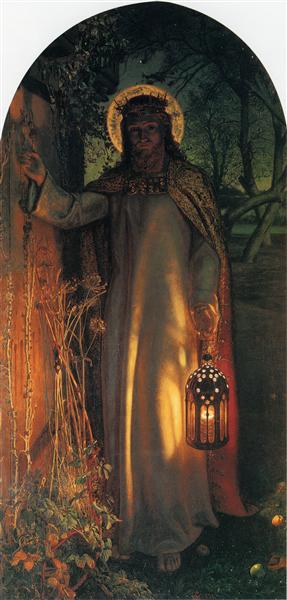Description
The work "The Light of the World" by William Holman Hunt, painted in 1851, is a powerful example of pre -Rrafaelita art, a movement that sought to return to the aesthetics and sincerity of painting before Rafael and the most academic styles that emerged afterwards later emerged . This painting is not only rich in symbolism, but also in its composition and in the way in which it connects visual elements with multiple levels of interpretation.
The work represents Jesus Christ, a central figure in the Christian tradition, in a scene that evokes a strong spiritual burden. The artist shows him standing in front of a closed door, symbolizing the invitation to humanity to open his heart in the light of faith and salvation. The door, located in a dark and gloomy environment, establishes a significant contrast with the luminosity of Christ himself, who is presented dressed in a characteristic robe in red and blue tones, colors that not only provide intense visual drama, but also have deep symbolic connotations: red can be interpreted as representative of sacrifice and passion, while blue suggests an aura of divinity and serenity.
Hunt's technique is meticulous and methodical, reflecting the naturalistic approach of the pre -Raphaelite movement. Every detail in the painting, from the wrinkles of the tunic to the delicate game of light on his face, is executed with a thoroughness that enriches the visual experience. This level of detail not only establishes a nearby connection between the viewer and the sacred figure, but also serves to highlight Hunt's dedication to the observation of nature and his desire to capture the reality in the most authentic way possible.
Intriguingly, the surrounding environment is populated with additional symbolism. At the bottom of the canvas, you can see a series of flowers that the artist included intentionally. Each of these flowers has a specific meaning in the context of the work: for example, the flower of passion refers to the passion of Christ. This use of the flora is not merely decorative, but in its complexity, it reinforces the message that each element of the scene is loaded with meaning and that the connection with the divine is in all aspects of creation.
The use of color in "the light of the world" is something that deserves a special consideration. The vibrant and carefully selected palette of Hunt complements the sense of hope and redemption emanating from the central figure. The extraordinary light that radiates of Christ becomes a symbol of guidance and salvation, contrasting drastically with the shadows that surround it. This not only generates a visual power, but also reflects the central message of the work: the light of Christ can even illuminate the darkest corners of the soul.
"The light of the world" is not only a masterpiece of pre -Rafaelism, but is also inserted in a broader dialogue on the use of light and religious symbolism in art. Hunt, along with his pre -Rafaelitas colleagues, sought to connect art with a sense of morality and truth, an approach that can be traced in works by other artists of the time, such as Dante Gabriel Rossetti and John Everett Millais. However, Hunt's uniqueness lies in its symbolic depth and its commitment to the observed detail, singularities that are consolidated in "the light of the world."
In short, "the light of the world" is a visual comment on spirituality and faith, framed in an aesthetic context that invites contemplation. It is a reminder that light and darkness coexist, and that openness to light can bring hope and redemption. The work remains relevant and resonant, inviting each observer to reflect on their own spiritual path and their relationship with the world around it.
KUADROS ©, a famous paint on your wall.
Hand-made oil painting reproductions, with the quality of professional artists and the distinctive seal of KUADROS ©.
Reproduction service paintings With a guarantee of satisfaction. If you are not completely satisfied with the replica of your painting, we refund your money 100%.

